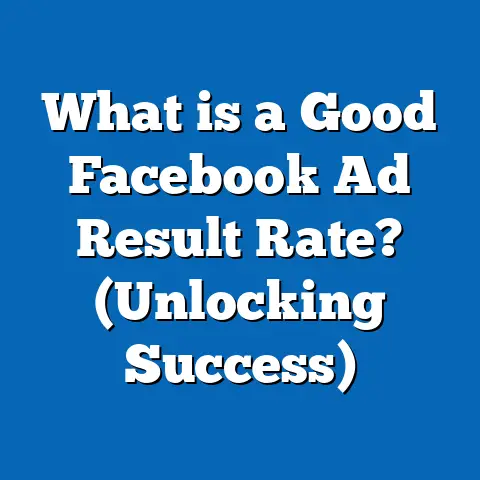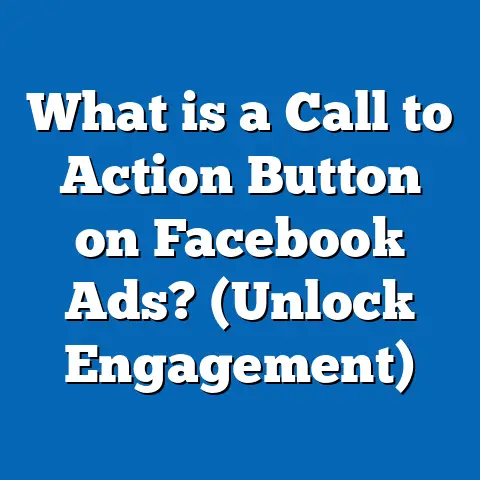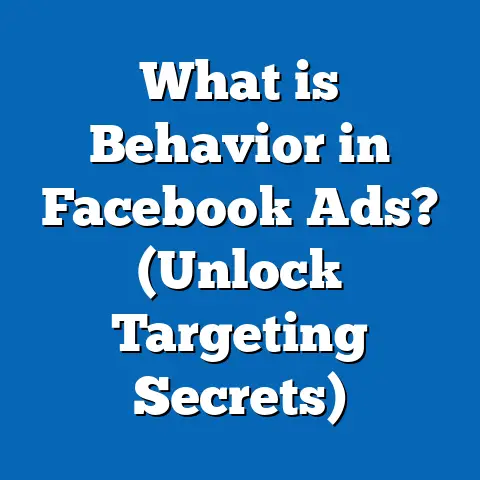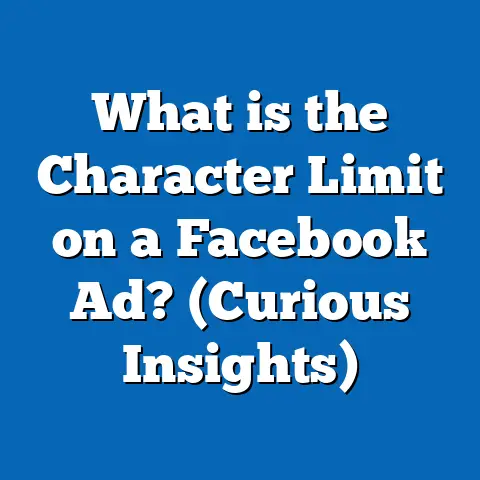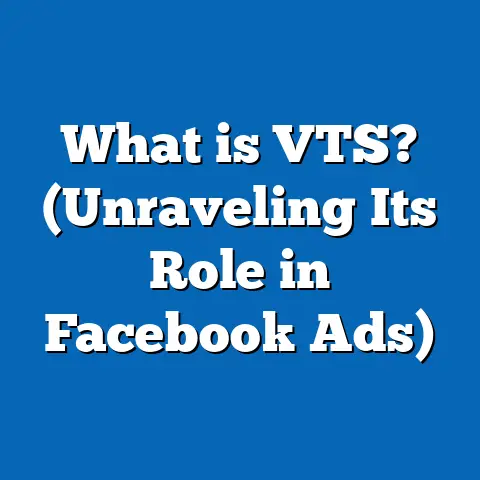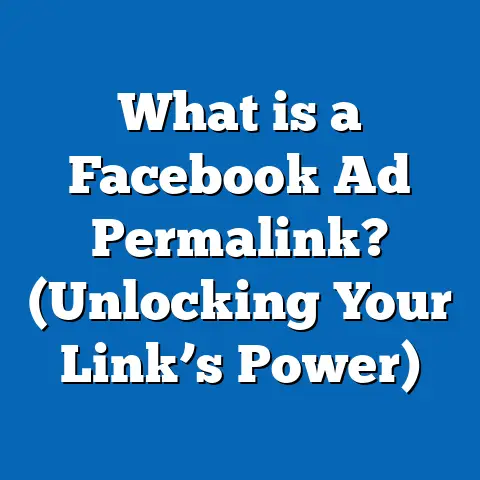What is an Ad Impression in Facebook Reels? (Unlocking Engagement)
What is an Ad Impression in Facebook Reels? (Unlocking Engagement)
Introduction: A Quirky Observation on Attention in the Digital Age
Have you ever noticed how quickly a new song or dance trend explodes on social media, only to vanish the next week? It’s as if our attention spans are doing acrobatics, flipping from one piece of content to another in milliseconds. In this lightning-fast world, understanding how many times your ad gets viewed—your “impressions”—can be the secret sauce to unlocking true engagement and marketing success.
Understanding Ad Impressions in Facebook Reels
What is an Ad Impression?
An ad impression occurs each time your ad is displayed on a user’s screen. It doesn’t require any interaction—simply appearing counts. For Facebook Reels, this means every time your video ad plays or is visible on the Reels feed, it registers as an impression.
In simpler terms, impressions measure exposure, not engagement. You might get thousands of impressions but far fewer clicks or conversions. Still, impressions are crucial because they represent the potential audience size that saw your message.
The Difference Between Impressions and Reach
It’s important to distinguish between impressions and reach, as marketers often confuse these two.
- Impressions count every time your ad is shown, including multiple times to the same user.
- Reach counts the number of unique individuals who have seen your ad at least once.
For example:
If your ad shows 100 times but only 40 people saw it, you have 100 impressions and a reach of 40.
Understanding this difference helps in evaluating campaign effectiveness. High impressions with low reach might indicate repeated exposure to a smaller audience, which can be good for brand recall but may also cause ad fatigue.
Why Are Impressions Important in Facebook Reels Advertising?
- Brand Awareness: Impressions help build recognition. The more people see your ad, the more familiar the brand becomes.
- Reach Measurement: Impressions indicate how widely your ad is distributed.
- Campaign Optimization: Tracking impressions over time helps identify which ads perform better.
- Cost Efficiency: Facebook charges advertisers partly based on impressions (CPM – cost per mille/impressions), so understanding impressions helps control expenditure.
- Algorithmic Impact: Facebook’s delivery system optimizes ads based on impression data to serve ads to users who are more likely to engage.
Facebook Reels: The New Frontier for Video Ads
The Rise of Facebook Reels
Since launching in 2020, Facebook Reels has grown explosively. By 2024, Reels accounted for over 50% of video consumption on Facebook platforms. This shift reflects changing user behavior favoring short, snackable video content.
According to Facebook’s internal data:
- Average daily time spent on Reels increased by 30% year-over-year.
- Advertisers saw up to a 20% higher engagement rate on Reels ads compared to traditional feed ads.
- Over 75% of users engage with at least one Reel daily.
These numbers highlight why marketers are shifting budgets toward Reels advertising.
Why Are Facebook Reels Ads Different?
Facebook Reels offers a full-screen vertical video experience designed for mobile users. This format demands different creative approaches than traditional feed or story ads.
Key differences include:
- Format: Vertical videos optimized for mobile screens.
- User Behavior: Users scroll quickly but expect immersive content.
- Algorithm: Prioritizes highly engaging content for wider distribution.
- Ad Placement: Appears seamlessly in between organic Reels content.
Marketers need to adapt their strategies accordingly to maximize impressions and engagement.
How Facebook Measures Ad Impressions in Reels
The Viewability Standard for Reels Ads
Facebook counts an impression for Reels ads when:
- The video starts playing and is visible on screen.
- At least 50% of the video frame is within the user’s viewport.
- The ad is not muted or skipped immediately (specifics vary by campaign objective).
This differs from traditional feed ads where impressions may count at a glance. The focus on viewability ensures impressions reflect actual exposure rather than accidental loads.
Technical Mechanism Behind Impression Counting
Facebook uses complex tracking pixels and viewability algorithms to determine if an ad was truly seen.
- Viewport Detection: Measures how much of the ad is visible.
- Playback Time: Minimum time thresholds (e.g., 1 second) must be met.
- User Interaction Signals: Scroll speed, mute status, and skips affect impression counting.
This ensures advertisers pay only for quality impressions likely to influence user behavior.
Deep Dive: Types of Impressions and Related Metrics in Facebook Reels Ads
Total Impressions vs. Unique Impressions
- Total impressions: Count every time your ad appears, including multiple views by the same user.
- Unique impressions: Count each user only once regardless of how many times they see the ad.
For example, if one viewer watches your ad 3 times, that’s 3 total impressions but 1 unique impression.
Viewable Impressions
Facebook prioritizes “viewable impressions,” where the ad is actually seen for a minimum duration (usually 1 second or more). This metric is key because it filters out ads technically served but ignored or unseen.
Engagement Metrics Related to Impressions
To evaluate impression quality, track:
- Click-through rate (CTR): Clicks divided by impressions — measures how compelling your ad is.
- Completion rate: Percentage of viewers who watch the entire Reel ad.
- Engagement rate: Likes, comments, shares relative to impressions.
- Frequency: Average number of times each user sees your ad.
Data-Backed Insights Into Facebook Reels Ad Impressions
Industry Benchmarks for CPM and CTR (2024)
| Industry | Average CPM (Cost per 1000 Impressions) | Average CTR | Average Completion Rate |
|---|---|---|---|
| Retail | $4.50 | 1.2% | 70% |
| Technology | $5.20 | 1.5% | 75% |
| Entertainment | $3.80 | 2.0% | 80% |
| Finance | $6.00 | 0.9% | 65% |
Facebook Reels ads tend to have higher completion rates than traditional feed or story ads due to their immersive full-screen format. Higher completion rates correlate with better brand recall and message retention.
User Behavior Patterns from Research
Research by Social Media Examiner shows:
- Users spend an average of 28 minutes daily watching Facebook Reels.
- 61% of users say they discover new products through Reels ads.
- Shorter videos (10–15 seconds) have a 35% higher completion rate than longer ones.
Case Studies: Real-World Successes Using Facebook Reels Impressions
Case Study #1: Boosting Brand Awareness with Facebook Reels Impressions
Client: A mid-sized fashion retailer targeting Gen Z customers.
Objective: Increase brand recognition and app downloads.
Strategy: Ran a series of 15-second Reels ads optimized for maximum impressions and viewability.
Results:
- Achieved 3 million total impressions in two weeks.
- Unique impressions reached 1.2 million users.
- CTR was 1.8%, above industry average.
- App downloads increased by 25%.
Insight: Prioritizing high-quality creative content that captures attention within the first few seconds boosted both impressions and engagement.
Case Study #2: Driving Conversions Through Impression Frequency Control
Client: A fintech startup promoting a new savings app.
Challenge: Too frequent ad exposure was causing ad fatigue and reduced CTR.
Approach:
- Monitored frequency metrics closely using Facebook Ads Manager.
- Limited exposure to no more than three impressions per user weekly.
- Created multiple variations of the ad creative for rotation.
Outcome:
- CTR improved by 30%.
- Conversion rate increased by 18%.
- Cost per acquisition (CPA) dropped by 22%.
This shows managing impression frequency is critical for maintaining engagement without overwhelming users.
Comparing Facebook Reels Ad Impressions with Other Platforms
Instagram Reels vs. Facebook Reels
While both platforms use similar algorithms, Instagram tends to have younger audiences with higher engagement rates but slightly higher CPMs (around $5.50 vs. $4.75 on Facebook).
Instagram users are more likely to engage with influencer-driven content, while Facebook’s broader demographic offers scale advantages.
TikTok Ads
TikTok leads in short-form video engagement with CPMs around $3-$4 but often demands more creative risk-taking due to its viral nature.
TikTok’s algorithm enables rapid organic reach growth, making it highly attractive for brand discovery but less predictable for consistent impression delivery.
YouTube Shorts Ads
YouTube Shorts ads are newer and less mature but provide longer video formats (up to 60 seconds) and integration with search intent, resulting in lower impressions but higher conversion rates from intent-driven viewers.
Technical Breakdown: How Facebook’s Algorithm Influences Ad Impressions on Reels
Ad Auction Dynamics
Facebook uses an auction system where advertisers bid for impressions based on target audience, budget, and relevance score.
- Higher bids increase impression share.
- Relevance scores affect ad delivery quality.
- User behavior influences frequency capping (how often an individual sees the ad).
Facebook’s goal is to maximize value for both advertisers and users by showing relevant ads likely to engage each person.
Machine Learning in Optimizing Impressions
Facebook’s AI analyzes user interactions (watch time, skips, shares) to predict which ads will perform better and serve those more often, maximizing valuable impressions rather than just total volume.
The AI also adapts delivery based on campaign objectives like brand awareness (maximizing impressions) or conversions (focusing on clicks).
Practical Tips for Maximizing Ad Impressions on Facebook Reels
1. Create Compelling Content Immediately
The first 3 seconds are critical; grab attention fast with bold visuals or intriguing hooks that make viewers stop scrolling.
Examples:
- Start with a surprising fact or question.
- Use bright colors or fast cuts.
2. Leverage Targeting Options
Use detailed demographics, interests, and behavior targeting to reach relevant audiences rather than broad groups that waste impressions.
Use Custom Audiences from website visitors or customer lists and Lookalike Audiences for expansion.
3. Optimize Video Length
Keep videos between 10 to 15 seconds for best completion rates. Longer videos risk drop-offs before key messages are delivered.
4. Use Captions
Many users watch without sound; captions improve viewability and comprehension.
5. Test Different Creatives Frequently
Rotate ads frequently to avoid fatigue and maintain high impression rates. Test variations in messaging, visuals, and calls-to-action.
6. Monitor Frequency Closely
Avoid audience burnout by controlling how often users see your ad. Use frequency capping features in Ads Manager.
Advanced Strategies: Beyond Just Counting Impressions
Combining Impressions with Engagement Metrics
Don’t rely solely on impressions. Look at how impressions convert into meaningful actions such as clicks, shares, or website visits.
Use multi-metric analysis combining CPM, CTR, completion rate, and conversion data for holistic campaign evaluation.
Retargeting Based on Impression Data
Use impression data to segment audiences who saw but didn’t interact with your ad and retarget them with tailored messages or offers to nurture conversions.
Cross-Platform Impression Analysis
Integrate data from Facebook Reels with other marketing channels (Instagram, TikTok) for holistic campaign optimization using tools like Facebook Attribution or third-party dashboards.
Measuring Success: Tools & Metrics You Should Track
Facebook Ads Manager Metrics Overview:
- Impressions: Total times ads were shown.
- Reach: Unique users who saw ads.
- Frequency: Average number of times each person saw ads.
- CPM: Cost per thousand impressions.
- CTR: Clicks divided by impressions.
- Video Plays at Various Durations: Plays at 3 secs, 10 secs, and complete plays.
These metrics help you analyze both quantity and quality of impressions.
Third-party Tools & Analytics
Tools like Hootsuite Ads, Sprout Social, or SEMrush provide deeper insights into cross-platform performance and trend analysis over time.
Future Trends in Facebook Reels Advertising & Impressions
Increased Automation & AI Integration
Facebook continues enhancing AI-driven optimization for smarter impression delivery based on real-time user behavior signals.
Augmented Reality (AR) & Interactive Ads
AR experiences integrated into Reels ads could increase engagement rates and thus improve impression effectiveness by making views more meaningful.
Greater Emphasis on Privacy & Data Transparency
New regulations will impact targeting precision; impression metrics will need careful interpretation alongside privacy-compliant data sources.
Summary and Next Steps for Marketers
Key Takeaways:
- An ad impression in Facebook Reels means your video ad was displayed visibly to a user.
- Impressions are essential for measuring brand exposure but should be analyzed alongside engagement metrics.
- Facebook’s focus on viewable impressions ensures higher quality audience reach.
- Short-form video ads like Facebook Reels command high completion rates and strong engagement when done right.
- Industry benchmarks provide useful guidance but testing and optimization are crucial.
- Advanced strategies like retargeting and cross-platform analysis help maximize ROI beyond raw impressions.
Next Steps:
- Audit your current Facebook Reels campaigns focusing on impression quality vs quantity.
- Experiment with creative formats optimized for quick attention-grabbing.
- Use Facebook Ads Manager reports to track viewable impressions specifically.
- Implement frequency caps and retargeting sequences based on impression data.
- Stay updated with evolving Facebook features and algorithm changes affecting ad delivery.
By mastering the concept of ad impressions on Facebook Reels, marketers can unlock greater engagement potential and drive more effective advertising outcomes in today’s fast-moving digital landscape.

